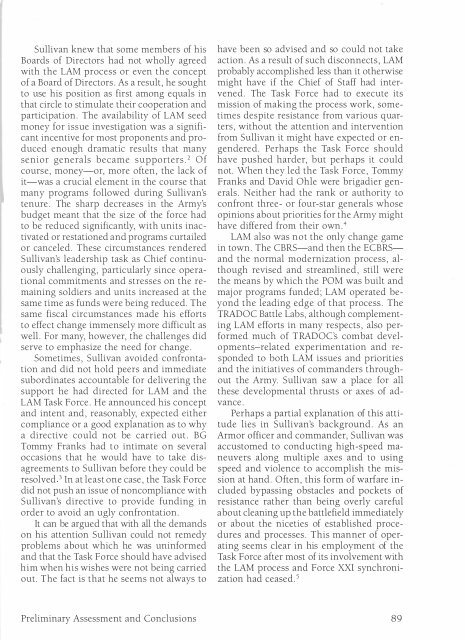The Modern Louisiana Maneuvers - US Army Center Of Military History
The Modern Louisiana Maneuvers - US Army Center Of Military History
The Modern Louisiana Maneuvers - US Army Center Of Military History
Create successful ePaper yourself
Turn your PDF publications into a flip-book with our unique Google optimized e-Paper software.
Sullivan knew that some members of his<br />
Boards of Directors had not wholly agreed<br />
with the LAM process or even the concept<br />
of a Board of Directors. As a result, he sought<br />
to use his position as first among equals in<br />
that circle to stimulate their cooperation and<br />
participation. <strong>The</strong> availability of LAM seed<br />
money for issue investigation was a significant<br />
incentive for most proponents and produced<br />
enough dramatic results that many<br />
senior generals became supporters 2 <strong>Of</strong><br />
course, money-or, more often, the lack of<br />
it-was a crucial element in the course that<br />
many programs followed during Sullivan's<br />
tenure. <strong>The</strong> sharp decreases in the <strong>Army</strong>'s<br />
budget meant that the size of the force had<br />
to be reduced significantly, with units inactivated<br />
or restationed and programs curtailed<br />
or canceled. <strong>The</strong>se circumstances rendered<br />
Sullivan's leadership task as Chief continuously<br />
challenging, particularly since operational<br />
commitments and stresses on the remaining<br />
soldiers and units increased at the<br />
same time as funds were being reduced. <strong>The</strong><br />
same fiscal circumstances made his efforts<br />
to effect change immensely more difficult as<br />
well. For many, however, the challenges did<br />
serve to emphasize the need for change.<br />
Sometimes, Sullivan avoided confrontation<br />
and did not hold peers and immediate<br />
subordinates accountable for delivering the<br />
support he had directed for LAM and the<br />
LAM Task Force. He announced his concept<br />
and intent and, reasonably, expected either<br />
compliance or a good explanation as to why<br />
a directive could not be carried out. BG<br />
Tommy Franks had to intimate on several<br />
occasions that he would have to take disagreements<br />
to Sullivan before they could be<br />
resolved 3 In at least one case, the Task Force<br />
did not push an issue of noncompliance with<br />
Sullivan's directive to provide funding in<br />
order to avoid an ugly confrontation.<br />
It can be argued that with all the demands<br />
on his attention Sullivan could not remedy<br />
problems about which he was uninformed<br />
and that the Task Force should have advised<br />
him when his wishes were not being carried<br />
out. <strong>The</strong> fact is that he seems not always to<br />
Preliminary Assessment and Conclusions<br />
have been so advised and so could not take<br />
action. As a result of such disconnects, LAM<br />
probably accomplished less than it otherwise<br />
might have if the Chief of Staff had intervened.<br />
<strong>The</strong> Task Force had to execute its<br />
mission of making the process work, sometimes<br />
despite resistance from various quarters,<br />
without the attention and intervention<br />
from Sullivan it might have expected or engendered.<br />
Perhaps the Task Force should<br />
have pushed harder, but perhaps it could<br />
not. When they led the Task Force, Tommy<br />
Franks and David Ohle were brigadier generals.<br />
Neither had the rank or authority to<br />
confront three- or four-star generals whose<br />
opinions about priorities for the <strong>Army</strong> might<br />
have differed from their own.4<br />
LAM also was not the only change game<br />
in town. <strong>The</strong> CBRS-and then the ECBRSand<br />
the normal modernization process, although<br />
revised and streamlined, still were<br />
the means by which the POM was built and<br />
major programs funded; LAM operated beyond<br />
the leading edge of that process. <strong>The</strong><br />
TRADOC Battle Labs, although complementing<br />
LAM efforts in many respects, also performed<br />
much of TRADOC's combat developments-related<br />
experimentation and responded<br />
to both LAM issues and priorities<br />
and the initiatives of commanders throughout<br />
the <strong>Army</strong>. Sullivan saw a place for all<br />
these developmental thrusts or axes of advance.<br />
Perhaps a partial explanation of this attitude<br />
lies in Sullivan's background. As an<br />
Armor officer and commander, Sullivan was<br />
accustomed to conducting high-speed maneuvers<br />
along multiple axes and to using<br />
speed and violence to accomplish the mission<br />
at hand. <strong>Of</strong>ten, this form of warfare included<br />
bypassing obstacles and pockets of<br />
resistance rather than being overly careful<br />
about cleaning up the battlefield immediately<br />
or about the niceties of established procedures<br />
and processes. This manner of operating<br />
seems clear in his employment of the<br />
Task Force after most of its involvement with<br />
the LAM process and Force XXI synchronization<br />
had ceased.s<br />
89
















